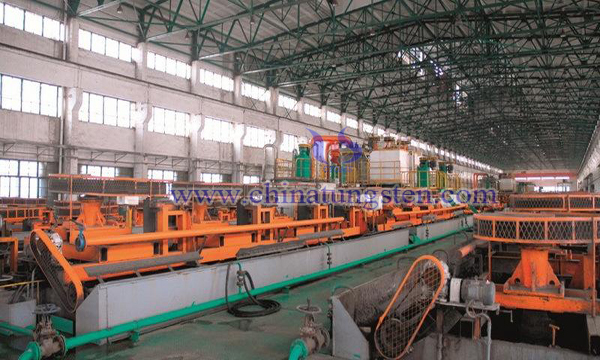Scheelite Beneficiation Wastewater Treatment Process
- Details
- Category: Tungsten Information
- Published on Monday, 20 May 2019 22:45
Under the existing technical system, a large amount of sodium silicate (sodium silicate) is usually added to the flotation process of scheelite to form a very stable colloidal dispersion system of fine particles in the pulp, which is conducive to flotation. However, a large amount of water glass wastewater has also been produced after flotation.

In view of the problems of high energy consumption, high cost and poor effect in the existing scheelite beneficiation wastewater treatment process, some researchers have proposed a scheelite beneficiation wastewater treatment process, which can reuse the treated wastewater for Scheelite beneficiation or direct discharge. The process includes the following steps:
A.Adding lime to scheelite beneficiation wastewater and adjusting the pH value to 11-12 can not only destroy the colloidal stability of wastewater, but also precipitate and remove heavy metal ions in wastewater at the same time.
B.After destabilization and precipitation, solid-liquid separation can be achieved by using a filter press, which includes a box filter press, a belt filter press, a diaphragm filter press or a plate-frame filter press. The main purpose is to achieve solid-liquid separation.
C.The solid is discharged into the tailings reservoir, the effluent of the filter press enters the first-order reaction tank, and sodium carbonate is added to the first-order reaction tank, which is fully mixed with sodium carbonate.
D.Mixed water enters the secondary reactor and PAM is added to the secondary reactor to flocculate with PAM.
E.Self-flow into sedimentation tank, solid-liquid separation by gravity, bottom concentrated sludge discharged into tailings reservoir;
F.The supernatant enters the Micro-flocculation screening program to further remove suspended particulate matter from wastewater. The micro-flocculation screening program needs to be backwashed regularly to prevent blockage. 5% of the Micro-flocculation screening program effluent is discharged into tailings reservoir as backwash water.
G.The pH value was adjusted to 6-9 by adding concentrated sulfuric acid into the effluent of G and 95% of the microflocculation screening program.
H.The effluent enters the micro-eddy reactor to further intercept the mixed white suspended particulate matter, such as silicate sol, residual calcium carbonate and calcium silicate, which are precipitated due to the change of pH value. The micro-eddy reactor needs to be washed regularly to prevent the intercepted particulate matter and sol from flowing with the effluent. 5% of the effluent of the micro-eddy reactor is discharged into the tailings reservoir as the flushing water.
I. 95% of the effluent from micro-eddy reactor can be reused for Scheelite beneficiation or direct discharge after removing supersaturated carbon dioxide by degassing tower. The effluent water quality index can reach the first level of the Comprehensive Wastewater Discharge Standard (GB8978-1996). 95% of the effluent from the micro-eddy current reactor is reused for Scheelite beneficiation or direct discharge after removing supersaturated carbon dioxide from the degasser. The treated effluent meets the standard of water quality for flotation process, improves the reuse rate of wastewater, and saves water resources.
Compared with the traditional process, the new process does not need electricity, low energy consumption, no need to use electrodes, and there is no problem that the electrodes are polluted for a long time, which affects the treatment effect. In the process of treatment, no excessive oxidant is added, which reduces the input cost, and there is no residue in the effluent, which does not affect the water quality, and also reduces the cost of wastewater treatment.
- Tungsten Manufacturer & Supplier, Chinatungsten Online: www.chinatungsten.com
- Tungsten News & Prices of China Tungsten Industry Association: www.ctia.com.cn
- Molybdenum News & Price: news.molybdenum.com.cn
- Tel.: 86 592 5129696; Fax: 86 592 5129797; Email: sales@chinatungsten.com



 sales@chinatungsten.com
sales@chinatungsten.com